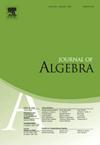在刚体变异上,等值于曲线的乘积
IF 0.8
2区 数学
Q2 MATHEMATICS
引用次数: 0
摘要
在这篇笔记中,我们研究了在有限群的自由作用下作为曲线乘积的商来实现的刚性复流形。它们是波维尔曲面的高维类似物。在假定流形是对角的,流形是一般类型的前提下,我们利用均匀化理论,通过与群相关的特定组合数据来描述这些流形的特征。这就引出了n倍波维尔结构的概念。我们定义了一个作用于给定有限群的所有n重Beauville结构的集合,使我们能够区分底层刚性流形的生物全纯类。作为应用,我们给出了在三维情况下具有群Z52的流形的分类,并证明了这是在三条曲线的积上允许刚性、自由和对角作用的最小可能群。此外,我们给出了对全纯欧拉数χ(OX)≥- 5的任意值忠实作用于每个因子的群给出的刚性3-fold X的分类。本文章由计算机程序翻译,如有差异,请以英文原文为准。
On rigid varieties isogenous to a product of curves
In this note, we study rigid complex manifolds that are realized as quotients of a product of curves by a free action of a finite group. They serve as higher-dimensional analogues of Beauville surfaces. Using uniformization, we outline the theory to characterize these manifolds through specific combinatorial data associated with the group under the assumption that the action is diagonal and the manifold is of general type. This leads to the notion of a n-fold Beauville structure. We define an action on the set of all n-fold Beauville structures of a given finite group that allows us to distinguish the biholomorphism classes of the underlying rigid manifolds. As an application, we give a classification of these manifolds with group in the three dimensional case and prove that this is the smallest possible group that allows a rigid, free and diagonal action on a product of three curves. In addition, we provide the classification of rigid 3-folds X given by a group acting faithfully on each factor for any value of the holomorphic Euler number .
求助全文
通过发布文献求助,成功后即可免费获取论文全文。
去求助
来源期刊

Journal of Algebra
数学-数学
CiteScore
1.50
自引率
22.20%
发文量
414
审稿时长
2-4 weeks
期刊介绍:
The Journal of Algebra is a leading international journal and publishes papers that demonstrate high quality research results in algebra and related computational aspects. Only the very best and most interesting papers are to be considered for publication in the journal. With this in mind, it is important that the contribution offer a substantial result that will have a lasting effect upon the field. The journal also seeks work that presents innovative techniques that offer promising results for future research.
 求助内容:
求助内容: 应助结果提醒方式:
应助结果提醒方式:


